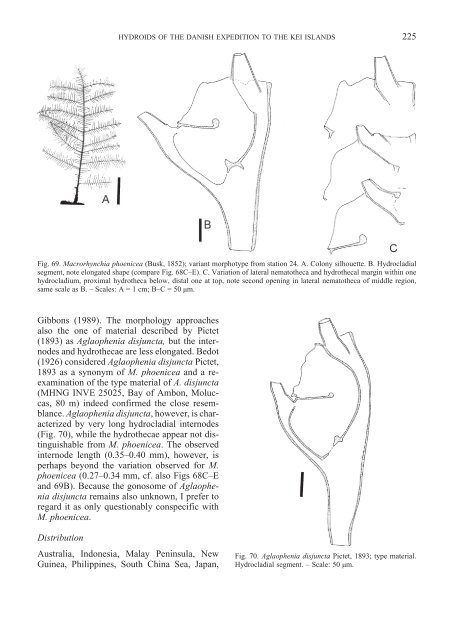Hydroids (Cnidaria, Hydrozoa) of the Danish expedition to
Hydroids (Cnidaria, Hydrozoa) of the Danish expedition to
Hydroids (Cnidaria, Hydrozoa) of the Danish expedition to
You also want an ePaper? Increase the reach of your titles
YUMPU automatically turns print PDFs into web optimized ePapers that Google loves.
HYDROIDS OF THE DANISH EXPEDITION TO THE KEI ISLANDS<br />
Fig. 69. Macrorhynchia phoenicea (Busk, 1852); variant morphotype from station 24. A. Colony silhouette. B. Hydrocladial<br />
segment, note elongated shape (compare Fig. 68C–E). C. Variation <strong>of</strong> lateral nema<strong>to</strong><strong>the</strong>ca and hydro<strong>the</strong>cal margin within one<br />
hydrocladium, proximal hydro<strong>the</strong>ca below, distal one at <strong>to</strong>p, note second opening in lateral nema<strong>to</strong><strong>the</strong>ca <strong>of</strong> middle region,<br />
same scale as B. – Scales: A = 1 cm; B–C = 50 µm.<br />
Gibbons (1989). The morphology approaches<br />
also <strong>the</strong> one <strong>of</strong> material described by Pictet<br />
(1893) as Aglaophenia disjuncta, but <strong>the</strong> internodes<br />
and hydro<strong>the</strong>cae are less elongated. Bedot<br />
(1926) considered Aglaophenia disjuncta Pictet,<br />
1893 as a synonym <strong>of</strong> M. phoenicea and a reexamination<br />
<strong>of</strong> <strong>the</strong> type material <strong>of</strong> A. disjuncta<br />
(MHNG INVE 25025, Bay <strong>of</strong> Ambon, Moluccas,<br />
80 m) indeed confirmed <strong>the</strong> close resemblance.<br />
Aglaophenia disjuncta, however, is characterized<br />
by very long hydrocladial internodes<br />
(Fig. 70), while <strong>the</strong> hydro<strong>the</strong>cae appear not distinguishable<br />
from M. phoenicea. The observed<br />
internode length (0.35–0.40 mm), however, is<br />
perhaps beyond <strong>the</strong> variation observed for M.<br />
phoenicea (0.27–0.34 mm, cf. also Figs 68C–E<br />
and 69B). Because <strong>the</strong> gonosome <strong>of</strong> Aglaophenia<br />
disjuncta remains also unknown, I prefer <strong>to</strong><br />
regard it as only questionably conspecific with<br />
M. phoenicea.<br />
Distribution<br />
Australia, Indonesia, Malay Peninsula, New<br />
Guinea, Philippines, South China Sea, Japan,<br />
225<br />
Fig. 70. Aglaophenia disjuncta Pictet, 1893; type material.<br />
Hydrocladial segment. – Scale: 50 µm.

















